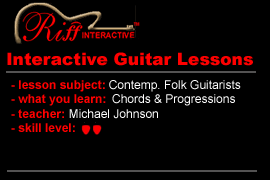Scroll through the lesson and click on notation/video/audio links to load the interactive players.
Please subscribe to get full access to all lessons for only $7.95/month PLUS 1 week free trial.

Riff Interactive lessons are
LESS expensive and
MORE interactive than alternatives!
More Info
|
|

Teacher: Welcome class to the lesson series on
Contemporary Folk Guitarists. This lesson will cover the style of David
Gray. David Gray is a Irish folk singer who was actually discovered and signed
by Dave Matthews. David's style features simplistic lines that sound great.
Unfortunately my computer was in the shop and I didn't have a chance to make the
videos, but I will add this later on with additional riffs. Make sure you check
back on the archive.
Lesson Sample - Lowband
- 800k
Lesson Sample -
Highband - 3.2 Meg
Teacher: The lesson sample should give you an
idea of the rhythms you will learn. Let's get started! This first rhythm pattern
starts in G Maj7.
Part 1
Teacher: Now the
fingering may be a little awkward to some. Notice how the 2nd finger holds the
root note (3rd fret/6th string). The tricky part is to play the higher notes.
Notice the hammer/pull-off combination. You have to arch the 3rd finger to let
the notes on the 1st string to stand out. Here's the jam
track.
Looping Jam
Track 1 - Lowband
Teacher:
I literally got my computer back a hour and 1/2 ago. So I didn't get a chance to
create as many parts as I would have liked. The video card went
out. OK, let's jump to the next
part.
Part
2
Teacher: This is a
cool sounding rhythm. Notice you start with a D Major and lift the 2nd finger on
the 1st string to play D Maj9. Notice the next chord shifts to the A Maj with a
G# bass note. You have a bit of a reach fretting the 6th string with your 3rd
finger. Notice that you can include the open A string (which is the root of the
chord) by arching the 3rd finger not to mute the 5th string open. Here's the jam
track.
Looping Jam
Track 2 - Lowband
Teacher:
David Gray uses a lot of open chord progressions, but can create some unique
variations to a standard progression. Remember Ireland is one of the original
homes of folk music. It's interesting how Irish folk has influenced all types of
American music styles. The roots of country, bluegrass, modern folk, etc can all
be traced back to the old country. OK, here's the next rhythm
pattern.
Part
3
Teacher: In this
example you use a descending run in the A Major scale. Notice you use the open A
as the drone or otherwise known as the "pedal tone." Notice how the open chords
(D & A) the phrase. The G and E give the phrase a since of resolve. Here's
the jam track.
Looping Jam Track 3 - Lowband
Teacher: Notice how
all the parts flow together with the descending drone-string run in A. I'll
send you the A Major scale extended on the D string.
A Major
Scale
Teacher:
See how the scale relates with the open A string.
A Major
w/open A Drone
Teacher:
OK, let's move to the next part. This next part uses a picking pattern while
holding a E5, this lays the foundation while you add other parts over this
phrase. Here's the main section.
Part 4
Teacher:
It's a pretty simplistic line using the E5, but the you briefly shift to the Maj
7 note (D#). Notice the A with the C# bass note as well. Using bass notes over
open chords is used often in folk. Here's the jam track.
Looping Jam
Track 4 - Lowband
Teacher:
Now David Gray will often add a counter rhythm/melody over the main rhythm
track. Here's one variation you can try.
Part 4b
MicroGlyphics:
It sounds sort of unresolved to me...that last bit.
Teacher: Yes Micro, this adds tension to the 2nd
track. These notes use the Root, Maj 3 and 4th. The 4th can also be called
an 11th note as well and leave the note sequence with the sound on tension.
Here's the jam track.
Looping Jam Track 4b - Lowband
Teacher:
See how both parts layer nicely. These simple melodies sound more complex when
played together. Let's try another variation over the E5.
Part 4c
MicroGlyphics:
He got a lot of room without the 3rd,
eh?
Teacher: This combination of notes uses the Root,
Maj 3rd and Maj 7th notes. Yes, Micro leaving out the perfect 5 does add a
different dimension to this voicing. Notice how the melody descends on the
2nd phrase. Here's a jam track with both parts.
Looping Jam
Track 4c - Lowband
Teacher:
This creates a nice sounding combination. Many folk players will focus on
layering simple parts. Most are very easy to play as you have found out in this
lesson.
Teacher: Well time to go, I'll update the archive
latter. See you next lesson.!
|
<< load notation from left
|
|
<< load audio from left
|
<< load audio from left
|